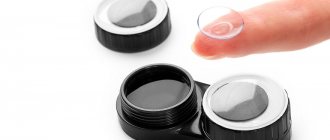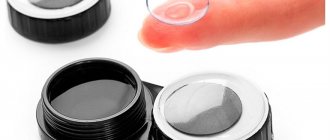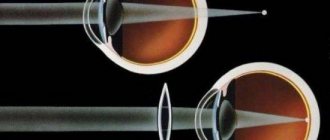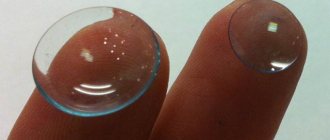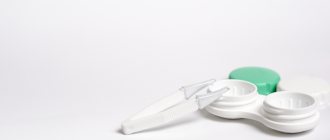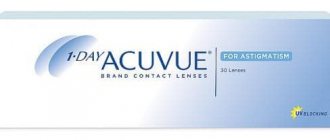Millions of Russians experience vision problems. The most common of them is myopia. According to Rospotrebnadzor, from 30% to 50% of children acquire this disease by the end of school. Today, there are two non-surgical methods of vision correction - glasses and contact lenses. Both methods have both supporters and opponents. Ophthalmologist Natalya Voroshilova told AiF.ru about the pros and cons of glasses and lenses .
Question and answer Will night lenses help restore vision in an adult?
Which method of non-surgical vision correction is better: glasses or contact lenses?
According to the expert, there is no clear answer to this question. Each has its pros and cons. “Glasses are a non-invasive method of vision correction because there is no contact with the eye, so there is no risk of infection of the ocular surface. Also, wearing glasses, unlike contact lenses, does not increase the risk of developing dry eye syndrome. The downside is that not everyone likes wearing glasses. There is a limitation of optics for different eyesight. On average, a well-tolerated difference does not exceed 3 diopters,” says Natalya Voroshilova.
As for soft contact lenses, their main advantages are a good cosmetic effect and visual comfort, the ophthalmologist believes. “Also, when wearing contact lenses, a person better tolerates more complete correction of high degrees of myopia, farsightedness and astigmatism,” says the ophthalmologist. The disadvantages of the method are the possibility of infection if lenses are not processed correctly and an increased risk of developing dry eye syndrome. Manipulating lenses requires a certain skill, but it is quite easy to develop. As long as good hand hygiene is practiced, daily lenses have minimal risks.
In Russia, night orthokeratology lenses, which patients use while sleeping, are also becoming popular. Their main advantage is that this is one of the most effective ways to control progressive myopia. Their disadvantages are the same as those of daytime lenses. But the method has limitations. According to the expert, orthokeratology lenses can be worn with myopia up to - 8.0 D, hyperopia - 6.0 D and astigmatism up to 5 D. There are also a number of absolute and relative contraindications.
Question answer
How to choose the right contact lenses?
Pros of contact lenses
There are many positive aspects to contact lenses that make patients choose them. They can completely replace glasses, correcting farsightedness and nearsightedness.
Correction of visual acuity
Contact lenses correct nearsightedness and farsightedness. This is done using a soft surface that rests on the mucous membrane of the eyes. A small gap remains, which is filled with tear fluid. It is located in the center, in the pupil area. The presence of a gap allows you to improve visual acuity.
In addition to correcting visual acuity, the lenses allow you to see objects from the side. This is not possible with glasses; there is no peripheral vision.
Ease of use
When wearing glasses, inconvenience arises due to their fogging and contamination. You must carry the case with you at all times. When using lenses, this need disappears. The couple is constantly in the eyes, a person does not feel it.
When using lenses, you can lead an active lifestyle, play sports, and swim.
In bad weather conditions such as snow or rain, the glasses are not suitable. They quickly fog up or become wet. Contact lenses do not have these disadvantages.
Aesthetic appearance
Models that are transparent are not visible to the eye. They do not change a person's appearance the way glasses do. Therefore, the advantage of lenses is aesthetics.
It is possible to use colored or tinted contact lenses that improve a person's appearance. It is possible to change your appearance temporarily.
No risk of injury
If the person is a driver, glasses are dangerous in emergency situations. With severe bruises, they can damage the skin of the face or eye tissue. When wearing lenses, this disadvantage is completely eliminated.
According to manufacturing materials
Read on - night lenses for vision correction. How to safely restore vision?
In the article (tyts) what is blepharospasm.
Treatment with folk remedies for Sjögren's syndrome! https://moezrenie.com/bolezni/narusheniya-tsirkulyatsii-vodyanistoj-vlagi/sindrom-shegrena.html
Main types
This classification divides lenses into:
- hard,
- soft (hydrogel and silicone hydrogel).
Most people wear soft lenses (about 90%).
Safe wearing of lenses during the day is ensured by the oxygen transmittance of the material from 24 to 26 units. Safe sleep in lenses is guaranteed with this parameter at least 87 units. The latest generation silicone hydrogel lens has this indicator of 100-140 units.
Pros and cons of soft lenses
Based on their properties, the materials used for soft lenses are divided into:
- Nonionic polymers with low humidity (less than 50%) and high humidity (more than 50%).
- Ionic polymers with low humidity (less than 50%) and high (more than 50%).
Popular silicone hydrogel lenses belong to the low moisture content group. They are characterized by excellent durability and strength. They are thinner and more technologically advanced to manufacture. But they have low oxygen permeability, which contributes to the development of corneal edema.
Lenses with a high moisture content are more comfortable. A person adapts to them faster and can wear them longer. However, they are distinguished by their fragility and frequent formation of large deposits (especially group 4 lenses). These lenses quickly dehydrate on the eye and sometimes do not provide stable visual acuity.
Lenses made from ionic polymers are more likely to accumulate protein deposits compared to non-ionic polymers.
Features of hard lenses
They are made of elastic thermoplastic. Their main disadvantage is airtightness. Another disadvantage is the tendency for protein to form under the lenses.
But their advantages are impressive:
- strength,
- ease of care,
- corneal astigmatism is corrected by several diopters,
- They are easier to put on and take off than soft ones because they have a larger diameter.
Advantages and disadvantages of lenses
Compared to glasses, lenses have many advantages: they enable people who previously wore glasses to see the world in new colors. Contact lenses help patients with very poor vision achieve clearer vision. With the help of contact correction, all objects are perceived naturally, as if a person were looking at them with the naked eye.
Glasses limit a person's movements: it is difficult to run, jump, etc. in them. You can actively engage in sports while wearing lenses. You just need to remember that for water sports, such as swimming, you need to use additional goggles.
Glasses often fog up, but this does not happen with lenses. During hot periods, you can wear sunglasses over the lenses.
Modern contact lens manufacturers
Everything has its downsides. What disadvantages can be noted when using lenses?
- Even the thinnest and softest lenses are perceived by the cornea of the eye as a foreign object. For this reason, allergic reactions, irritation or inflammation may sometimes occur.
- If handled and worn incorrectly, lenses can cause damage to the eyes.
- Even the most modern lenses do not allow enough oxygen to reach the cornea of the eye. This leads to disruption of gas exchange in the eye and, as a result, to inflammatory or allergic reactions.
- It is difficult for a beginner to put on and remove lenses. You have to get used to this.
- Wearing contact lenses is not a cheap pleasure.
What lenses can be used if vision is good?
In this case, cosmetic optical products are ideal, which are divided into two subcategories: tint and color.
- Tinted models are created for people with light eyes. They allow you to highlight the natural beauty of the cornea and give it a new shade.
- Colored models will allow you to completely change your eye color. This is an excellent solution for those who want to transform themselves and create a unique image.
When purchasing these contact products, it is recommended to first consult with an ophthalmologist and undergo an examination. If the doctor confirms that correction is not required, you can choose models without diopters.
If you need to improve your visual acuity, your specialist will write a prescription for the purchase of lenses with the necessary parameters. This will allow you to see better. When purchasing lenses, you should also consider how you wear them. There are disposable models for the day, as well as products for the month, quarter and year.
It is permissible to use contact correction products at an age when a person can consciously handle and clean them. Experts do not recommend purchasing lenses for children under 14 years of age, as the child will not be able to cope with the care. If necessary, it is better to use glasses.
Cons of contact lenses
There are disadvantages of the models, the doctor warns about them. The patient must decide for himself whether he wants to wear glasses or contacts, taking into account their shortcomings.
Danger of bacterial infection
If the model is used incorrectly or hygiene rules are not followed, there may be a risk of bacterial infection. The lens contains pores in which pathogenic microorganisms accumulate.
If the pair is not immersed in a sterilizing solution or worn for too long, eye damage appears, which is expressed as:
- conjunctivitis;
- inflammation of the eyelids;
- inflammation of eye tissue.
Drying of the mucous membrane of the eyes
When worn for a long time, the eyes may dry out, since the tear fluid contained between the pair and the mucous membrane gradually disappears. The person feels irritated and uncomfortable. Begins to feel lenses in eyes.
The need to use additional devices
If the patient does not use daily lenses, it is necessary to purchase a container and storage solution. The container gets dirty quickly, so it needs to be changed periodically. The patient must carry these items with him in order to remove a pair in case of emergency.
Price
The shorter the shelf life of the lenses, the more expensive they are. One-night stands are the most expensive. They are bought 2 times a month, since the package contains 15 pairs. Longer-lasting styles are a little cheaper, but not as soft as one-day pairs.
Inability to wear lenses during eye treatment
When using drops or ointments to treat eye diseases, doctors recommend not wearing contact lenses. This is due to blurred vision or accumulation of the drug in the pores of the model. During treatment, lenses may irritate or damage the mucous membrane of the eyes.
Painful addiction
For many patients, getting used to contact lenses in the first week is painful. This is due to the sensitivity of the mucous membrane of the eyes or incorrect selection of a pair. Increased lacrimation, redness, and inflammation occur. Over time, these sensations pass.
The need for frequent visits to the ophthalmologist
When wearing contact lenses, the patient should periodically visit doctors to avoid the risk of inflammatory eye diseases or changes in visual acuity. Over time, lenses can damage the mucous membrane of the eyes. Therefore, during medical examination, the doctor checks this parameter.
Hygiene monitoring
When wearing lenses, the patient must be careful about personal hygiene. Only pure vapors placed in solution are used. Before installing them, it is important to wash your hands with germicidal soap. In certain situations, a person may break this rule, which will lead to the development of a bacterial infection.
Author's rating
Author of the article
Alexandrova O.M.
Articles written
2029
about the author
Was the article helpful?
Rate the material on a five-point scale!
( 1 ratings, average: 5.00 out of 5)
If you have any questions or want to share your opinion or experience, write a comment below.
Pros and cons of different types of lenses
| Type of contact lenses | Advantages | Flaws |
| Soft | More flexible and comfortable Various temporary wearing modes are possible: from 1 day to several months Shorter adaptation period Stays better on the eye (even with intense physical activity) | Less durable Requires more frequent replacement Less effective in correcting some problems with vision, such as a high degree of astigmatism High infection rate |
| Hard | Optimal vision correction for many pathologies More durable Requires less frequent replacement Provides greater access of oxygen to the eyes | Needs more time to adapt May slip off the center of the eye Foreign objects penetrate the lens more easily |

